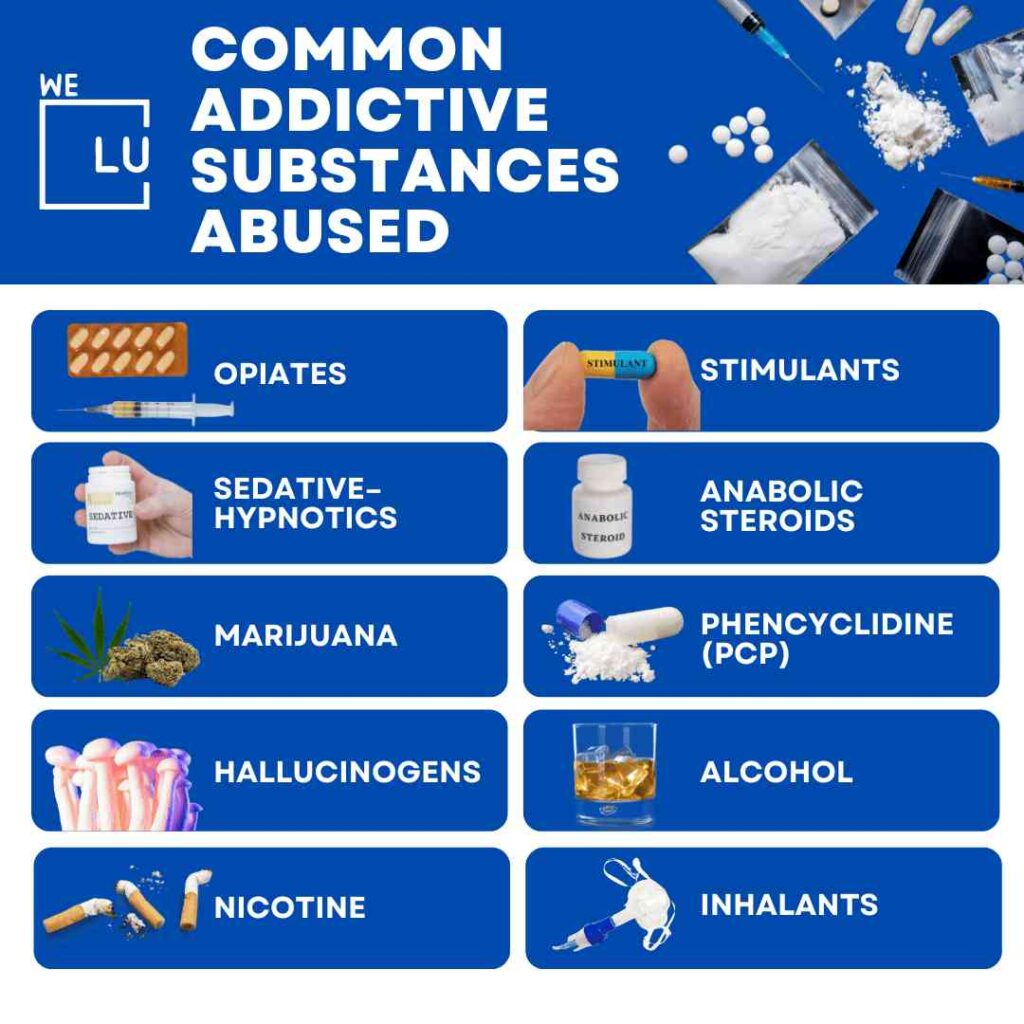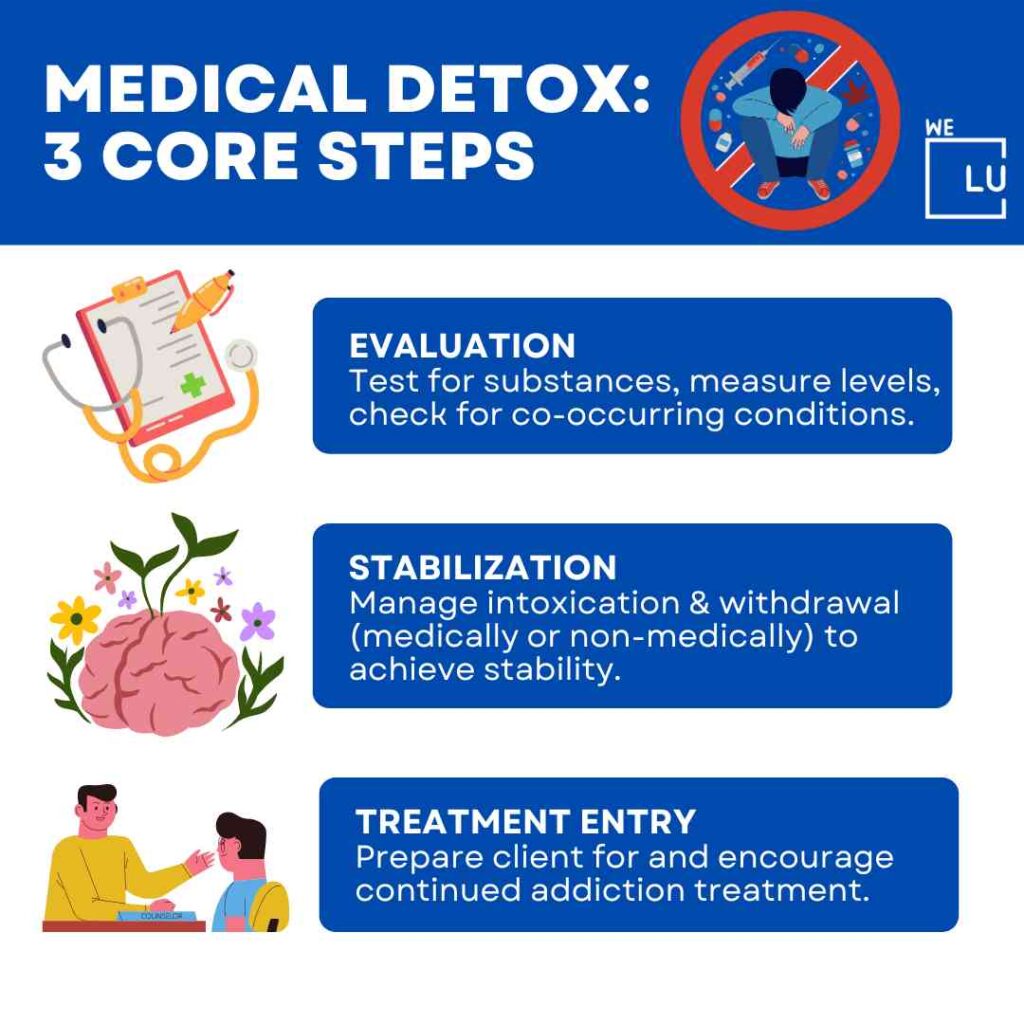What is Substance Abuse?
Substance abuse refers to excessive drug use that is detrimental to self, society, or both. This definition encompasses both physical dependence and psychological dependence.
Physical dependence caused by lengthened drug use refers to an altered physiologic state in which withdrawal symptoms develop when the drug is discontinued.
Psychologic dependence refers to a state of intense need to continue taking a drug in the absence of physical dependence. By these definitions, alcohol is a drug that can cause both physical and psychological dependence. [1]
Drug addiction is a chronic disease distinguished by compulsive or uncontrollable drug seeking and use despite adverse consequences and changes in the brain, which can be long-lasting. These changes in the brain can lead to the destructive behaviors observed in people who use drugs. Drug addiction is also a relapsing disease. Relapse is the return to drug use after an attempt to stop.
The path to drug addiction starts with the voluntary act of taking drugs. But over time, a person’s ability to choose not to do so becomes compromised.

Drug & Alcohol Substance Abuse
Many addicts take abusable substances as a means of alleviating anxiety or depression. Drug abusers who struggle primarily with depression usually prefer “uppers.” (stimulants) Those who suffer predominantly from anxiety tend to prefer “downers.” (sedatives)
But to further diagnose substance abuse, your physician must try to determine the extent to which drug and alcohol use interferes with your performance in work, family, education, and social relationships.
Alcohol is considered to be one of several drugs of abuse. However, it should be remembered that the extent of alcohol-related problems in the United States is so great that alcohol is often regarded in a separate category from other drugs of abuse. [2]
Because addiction is a chronic illness, people can’t simply stop using drugs for a few days and be cured. Instead, most patients or treatment clients need long-term or repeated care to discontinue using completely and recover their lives.
Addiction Treatment Must Help The Person Do The Following:
- Stop using drugs
- Stay drug-free
- Be productive in the family, at work, and in society
Common Addictive Substances Abused
- Opiates: Opiates act by binding to a variety of receptors that can influence mood, respiration, pain, blood pressure, endocrine function, and gastrointestinal function. Heroin is the most rapidly acting of the commonly abused opioids.
- Stimulants: The most common addictive stimulants are cocaine and amphetamines. Cocaine abuse has reached epidemic levels in this country.
- Sedative–Hypnotics: Substance abuse in this category generally involves benzodiazepines. Use of a benzodiazepine at even the therapeutic dosage for a month or more can produce physical dependence (especially with alprazolam). Thus, during treatment, it is important not to discontinue the drug abruptly, which may cause a potentially fatal withdrawal syndrome.
- Anabolic Steroids: These agents are used illegally to enhance physical appearance, athletic performance, and fighting ability. Adverse effects include a variety of physical effects on the cardiovascular, hepatic, and reproductive systems and psychiatric effects including episodes of depression, mania, psychosis, delirium, and marked aggressiveness.
- Marijuana: Addictive behavior patterns occur rarely, even with heavy use of marijuana. Likewise, dangerous physical reactions are uncommon with this substance abuse; the main physiologic effects of marijuana are increased appetite and a faster heartbeat, which is likely to be a problem only for persons with cardiovascular disease. However, the drug’s possible psychological effects are still considerably concerning.
- Phencyclidine (PCP): PCP or commonly known as “angel dust” is often smoked mixed with a leaf material (tobacco, marijuana). Even extremely low doses can precipitate a schizophrenia-like psychotic state. Death may occur, usually related to external events precipitated by drug use, including homicides, suicides, and accidents.
- Hallucinogens: Also known as psychotomimetics and/or psychedelics are a diverse group of extremely potent substances that generally produce stimulation at very low doses and hallucinations, delusions, depersonalization, and unpredictable behavior at higher doses.
- Alcohol: Alcohol consumption remains a subject of considerable concern. Most abusers of illicit drugs have abused alcohol in the past or will eventually do so.
- Nicotine: Smoking kills more than 1,000 Americans every day. Because the adverse effects of smoking become manifest over decades, young people are particularly unlikely to appreciate the reasons not to smoke.
- Inhalants: Inhalant refers to the common mode of administration rather than a particular category of substance abuse. The agents used in this manner consist of a variety of inexpensive, readily available volatile substances that provide a high; they include medical anesthetic gases (ether, chloroform, halothane, nitrous oxide); industrial or household solvents (paint thinners, degreasers, solvents in glue); art- and office-supply solvents (correction fluid, solvents in marker pens); gases used in household or commercial products (butane lighters, gasoline, whipping cream dispensers, electronic equipment dusters, and cleaners, refrigerant replenishers); household aerosol propellants (as in paint, hair spray, and fabric-protector spray); and aliphatic nitrites (“poppers”). Note that smoked drugs are excluded from this category. [3]

In 1958, the American Medical Association (AMA) announced that alcoholism is a disease. This declaration suggested that alcoholism was a medical problem requiring medical intervention.
As defined by American Psychiatric Association [APA], a substance-related disorder is a “disorder related to the taking of a drug of abuse (including alcohol), to the side effects of a medication, and to toxin exposure.” In addition, the term substance “can refer to any drug of abuse, a medication, or a toxin.” Thus, the term substance refers to alcohol as well as other drugs of abuse.
In 1971, the National Conference of Commissioners on Uniform State Laws adopted the Uniform Alcoholism and Intoxication Treatment Act, which recommended that “alcoholics not be subjected to criminal prosecution because of their consumption of alcoholic beverages but rather should be afforded a continuum of treatment in order that they may lead normal lives as productive members of society.” [4]
Treatment programs and individual approaches continue to evolve and broaden, and many programs today do not fit neatly into traditional drug addiction treatment classifications.
Most, however, start with detoxification and medically managed withdrawal, often considered the first stage of treatment.
Detoxification is a set of interventions intended to manage severe intoxication and withdrawal. It denotes a clearing of toxins from the patient’s body who is acutely intoxicated and dependent on abused substances. In addition, detoxification seeks to minimize the physical harm caused by substance abuse.
The Most Common Substance Abuse Withdrawal Symptoms
- Sweating
- Excessive yawning
- Nausea
- Vomiting
- Runny nose
- Insomnia
- Anxiety
- Agitation
- Muscle aches
- Watery eyes
- Hunger
- Fatigue
- Diarrhea
- Hallucinations
- Seizures
- Tremors [5]
The Three Essential Components During Medical Detox
Detoxification is an overall process with three essential components that may take place concurrently or as a series of steps:
- Evaluation involves testing for the presence of substances of abuse in the bloodstream, measuring their concentration, and screening for co-occurring mental and physical conditions.
The assessment also includes a comprehensive evaluation of the client’s medical and psychological disorders and social situation to help determine the appropriate level of treatment following detoxification. Essentially, the assessment serves as the basis for the initial substance abuse treatment plan once the patient has successfully withdrawn.
- Stabilization includes the medical and psychosocial processes of assisting the client through severe intoxication and withdrawal to achieve a medically stable, fully supported, substance-free state. This often is done with the assistance of medications, though in some approaches to detoxification, no prescription is used.
In addition, stabilization includes familiarizing clients with what to expect in the treatment environment and their role in treatment and recovery. During this time, practitioners also seek the involvement of the client’s family, employers, and other significant people when appropriate and with confidentiality release.
- Fostering the client’s entry into treatment involves preparing the client for entry into substance abuse treatment by stressing the importance of following through with the complete substance abuse treatment continuum of care.
It is an important challenge for detoxification service providers to find the most effective way to foster a patient’s recovery. Effective detoxification includes the medical stabilization of the client and the safe and humane withdrawal from drugs, including alcohol, and entry into treatment.
Successfully associating detoxification with substance abuse treatment reduces the “revolving door” phenomenon of repeated withdrawals, saves money in the long run, and delivers the sound and humane level of care individuals need.
Substance Abuse and Addiction Detoxification Infographics
The infographic below illustrates substance abuse, which entails the excessive consumption of drugs with harmful effects on oneself, society, or both. This definition encompasses both physical and psychological dependencies.

Embed the above “Common Addictive Substances Abused” Infographic to your Website. This infographic is provided by the We Level Up Addiction Treatment Center team. To use the above infographics, you agree to link back and attribute its source and owner at https://weleveluptx.com/substance-abuse/
Common Addictive Substances Abused image link: https://weleveluptx.com/wp-content/uploads/2024/02/Common-Addictive-Substances-Abused-Substance-Abuse-and-Addiction-Detoxification-What-is-Substance-Abuse-Drug-Alcohol-Substance-Abuse-1024×1024.jpg

Embed the above “Medical Detox: 3 Core Steps” Infographic to your Website. This infographic is provided by the We Level Up Addiction Treatment Center team. To use the above infographics, you agree to link back and attribute its source and owner at https://weleveluptx.com/substance-abuse/
Medical Detox: 3 Core Steps image link: https://weleveluptx.com/wp-content/uploads/2024/02/Three-Essential-Components-During-Medical-Detox-Common-Addictive-Substances-Abused-Substance-Abuse-and-Addiction-Detoxification-What-is-Substance-Abuse-Drug-Alc-1024×1024.jpg
Substance Abuse Treatment Detox
It is advisable to detox in a rehab center to access qualified professionals who can manage comfortable drug, alcohol detox, and withdrawal complexities.
For anyone who suffers from addiction, just the thought of having to stop using can cause severe mental distress. But, with the help of a medical detox center, the medical detox process is managed.
A comprehensive team prescribing medications can alleviate your withdrawal pains while monitoring your health 24 hours. Thus, we are assuring both your safety and comfort.
The medically managed detox processes allow the body to process the substance of abuse in the system. And, it gently unaccustomed the body to its dependence on substances such as alcohol or drugs. It is the first stage of alcohol treatment and one you should seek before your addiction gets more damaging.
Withdrawal symptoms, make the process more stressful. In addition, the symptoms may seem to get worse through the detox process. That is why they need constant care and attention to help manage the symptoms with detox.
To start reclaiming your life from substance abuse, you may contact us here at We Level Up TX, and we will guide you to recovery.

Sources:
[1-2] Substance Abuse – National Center for Biotechnology Information
[3] Diagnosis and Treatment of Drug Abuse in Family Practice – American Family Physician Monograph – National Institute on Drug Abuse
[4] Detoxification and Substance Abuse Treatment – National Center for Biotechnology Information
[5] We Level Up – Locations » We Level Up Rehab Centers Locations